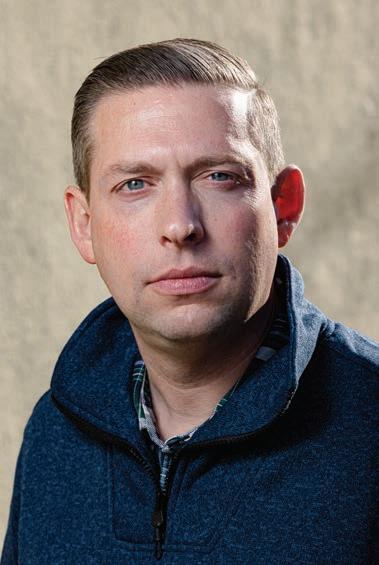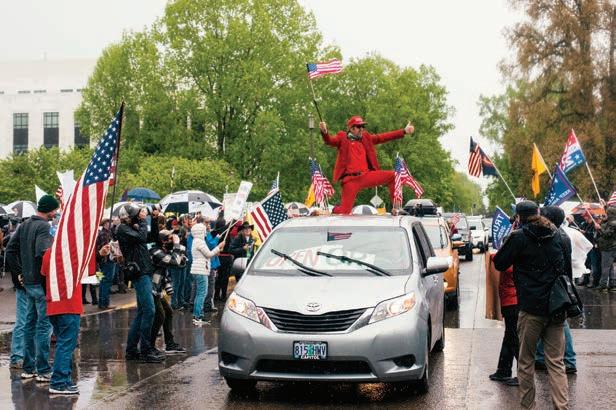
14 minute read
weeks after schoolteachers
MOTOYA NAKAMURA / MULTNOMAH COUNTY
LET’S GET SHOTS: Health care workers have begun receiving COVID-19 vaccinations across Oregon. Who goes next is a fraught question.
Advertisement
The Sticking Place
Gov. Kate Brown reversed herself twice last week on the date elderly Oregonians could get the coronavirus vaccine.
BY RACHEL MONAHAN rmonahan@wweek.com
On Jan. 15, Gov. Kate Brown took a parting shot at the outgoing Trump administration: She blamed a decision to move up COVID-19 vaccines for elderly Oregonians and then move them back again on the federal government’s failure to deliver promised vaccine reserves. Three days earlier, the governor had moved seniors to the front of the line for vaccines. When she learned more vaccines weren’t coming, she changed the plan again: Older Oregonians would have to wait another three weeks. “Let me be clear: This is a deception on a national scale,” she said at the Jan. 15 press conference. “I am shocked and appalled that the federal government would set an expectation with the American people on which they knew they could not deliver, with such grave consequences.” The reversal comes with high stakes attached, even as other states have already begun vaccinating seniors. People over 80 account for more than half of Oregon’s deaths from COVID-19, and people over 60 account for 90% of the deaths. As of now, Oregonians over 80 will be eligible for vaccines beginning Feb. 8—after medical workers, fi refi ghters and school teachers get the shots. The state will then lower the age bracket each week until everyone over 65 is eligible. It’s Brown’s last chance to blame Trump—and keep the public’s faith in Oregon’s choppy vaccine rollout. Brown’s double reversal shows the immense pressure the governor faces to return life to normal from COVID19 as soon as possible. But it also exposes the holes in Brown’s plan to get vaccines into the arms of Oregonians. Her decisions on which groups get priority for vaccines are last minute, placing sudden demand on hospitals and threatening to undermine public patience in seemingly arbitrary choices. Most notably, Brown is pressing to return students to school classrooms by Feb. 15—and assuaging the concerns of teachers unions about that plan by giving them early priority for vaccines. That’s an approach that few other states have tried. “Oregon is in a fairly unique standing throughout the nation in saying that teachers would be part of the Phase 1 rollout,” says Courtney Campbell, director of Oregon State University’s Program for Ethics, Science, and the Environment. Campbell said “health equity” has been a primary consideration for vaccine rollout both in Oregon and nationally—but teachers didn’t seem to fi t that standard. Instead, Brown and Oregon’s vaccine advisory committee could include additional considerations, such as saving “the most lives” and “giving primacy to fairness and transparency” to justify the choice. “If you’re going to work only with health equity, then it seems to me it’s hard to justify prioritizing K-12 personnel,” says Campbell. “Personally, I’m more concerned about the decision-making process,” says OSU public health professor Chunhuei Chi. “When you protect the teacher, don’t forget the children; when they come home, they have parents and sometimes grandparents. To be consistent, if the school reopening to in-person is a high priority, then it shouldn’t be just the teachers, it should be the parents.” Brown is undeterred. “Many school districts across the world have figured out how to get their students back into the classroom as safely as possible,” she said Jan. 15. “With the assistance of vaccines, with additional resources, and the work we’re doing on the ground to ensure that school districts have rapid testing capacity, I’m confi dent we can do this safely.” On Dec. 23, Brown said she would vaccinate teachers after health care workers, emergency responders and nursing home residents. At the same time, she announced plans to drop her requirements that counties lower the prevalence of COVID-19 before reopening schools, and she set a goal of Feb. 15 for returning students to classrooms. The compromise of giving teachers priority on vaccines while reopening schools as the virus continued to rage didn’t placate the Oregon Education Association, a powerful interest group the governor had sided with at times in keeping schools closed. “Our elected leaders should not and cannot allow political pressures to dictate the manner in which that data is implemented,” said OEA president John Larson on Dec 23. But older Oregonians saw a politically powerful special interest being bumped ahead of them in the line for a potentially lifesaving medical treatment. “Given that older individuals are at a greater risk of death from COVID-19, we strongly urge you to ensure that Oregonians age 50 and older are prioritized to receive a vaccine,” wrote Edward Brewington, volunteer state president of AARP Oregon, on Jan. 11. “These individuals must be given priority access to vaccines, in addition to those individuals receiving care in nursing homes and other long-term care facilities.” Then, on Jan. 12, Brown appeared to split the difference by offering both groups the vaccine. The federal government said it was opening its vaccine reserves—and Brown said she would vaccinate Oregonians over 65 beginning Jan. 23, the same day as teachers. The Oregon Health Authority says it projected the feds would send upward of 135,000 doses. But the feds never promised Oregon that number: “Those were our estimates based on the information we had,” says OHA director Pat Allen. O ering those doses to seniors would have created an enormous demand, with less than two weeks to prepare. About 19% of Oregonians are over 65, and all 795,000 would have been eligible to receive the vaccine starting the same day. “We were supportive but skeptical that the supply would meet this massive increase in the number of Oregonians who would become eligible,” said Becky Hultberg, president and CEO of the Oregon Association of Hospitals and Health Systems. Not all states made such drastic moves when the feds pledged more doses. Utah, for one, didn’t lower its age limit, though it had already begun to vaccinate older residents. “We don’t have enough vaccine assigned to the state of Utah right now to even cover those who are 70 years of age and over, over the next several weeks,” said Gov. Spencer Cox on Jan. 14, according to The Salt Lake Tribune. Then, on Jan. 15, citing a federal betrayal, Brown returned to her previous position: Older Oregonians (outside nursing homes or institutional settings) would have to wait. Teacher vaccines will begin no later than Jan. 25. That gives Oregon a little breathing room. But it’s still not clear whether teachers will be able to get both vaccine doses before Feb. 15, when Brown hopes schools will reopen. And hospitals noted the state has had an uneven record at planning for vaccinations to date. “From the beginning, the COVID-19 vaccine rollout has been unpredictable. At the 11th hour, hospitals shouldered a huge part of the burden for distribution of the doses, with little outside support,” Hultberg said. “The fact that the playing fi eld keeps changing makes this work even more di cult in the midst of a pandemic, as our overburdened sta s take care of a surge of patients.” As for schools reopening, the more contagious British variant of COVID-19 has arrived in Oregon—and with it the potential for more outbreaks. But on Jan. 19, the Oregon Department of Education further eased the guidelines for reopening schools in communities, including Portland, with higher case counts.
WESLEY LAPOINTE

Indivisible?


What can Democrats and Republicans still agree on? We asked Susheela Jayapal and Stan Pulliam.
BY NIGEL JAQUISS and
RACHEL MONAHAN 503-243-2122
On the morning Joe Biden is sworn in as the 46th president of the United States, we wake up in two Americas. Americans, and Oregonians, are more divided than they’ve been in most of our lifetimes. Left and right think the others are extremists, cannot agree on a common set of facts, and are at loggerheads on issues ranging from race and policing to the appropriate response to a pandemic that has killed more than 400,000 Americans. The peaceful transfer of power from President Donald Trump to President Joe Biden feels like no sure thing. On Jan. 6, a mob of Trump loyalists stormed the U.S. Capitol, seeking to stop Congress from certifying the results of the election. Oregon has not witnessed an armed insurrection like the one in Washington, D.C. But right-wing protesters fought with police Dec. 21 in Salem as they attempted to enter the state Capitol. Proud Boys and other armed extremists menaced Salem again Jan. 6. And in Portland, six months of protests against the police have devolved into vandalism that threatens the vitality of this city. Gov. Kate Brown has weathered five recall attempts; no sooner did Mayor Ted Wheeler win reelection in November than critics began working to recall him. After the November election, the Portland polling fi rm DHM Research checked in with Oregonians across the state and termed its fi ndings “disconcerting.” “Only 33% of us feel we can come together next year as Oregonians—urban and rural, Republican and Democrat, whites and communities of color—to make progress addressing these challenges and resetting Oregon,” the fi rm found. Oregon’s turmoil is a microcosm of the split that has turned Washington, D.C., this week into a heavily guarded fortress, with tens of thousands of National Guard troops, federal police and local cops armed to the teeth against those who deny—against all evidence—that Biden won. Civic discourse has rarely been less civil. And the need for it has never been more urgent. So last weekend, WW asked two emerging leaders in Oregon politics—one a Democrat, the other a Republican—to talk to each other. Multnomah County Commissioner Susheela Jayapal, 58, won a seat on the county board in 2018, becoming the first Indian American to hold office in Oregon. The forthright former corporate lawyer has a personal connection to the recent assault on Congress: Her sister, U.S. Rep. Pramila Jayapal (D-Wash.), contracted the coronavirus while sheltering during the assault with unmasked GOP colleagues. With Jayapal was Sandy Mayor Stan Pulliam, 39. An insurance executive who also won office in 2018, Pulliam knocked off a two-term incumbent to take leadership of one of Oregon’s fastest-growing cities, an hour’s drive east of Portland. Although Pulliam’s offi ce is nonpartisan (as is Jayapal’s), he’s a registered Republican whose outspoken criticism of Gov. Brown’s COVID-19 policies—including leadership of the New Year’s Day movement, in which 300 small businesses agreed to defy Brown’s COVID orders—has put him on the list of possible GOP candidates for governor in 2022. In a spirited conversation, Jayapal and Pulliam argued whether progressives or conservatives were responsible for most of the unrest roiling Oregon. They challenged each other on whether COVID-19 lockdowns have prevented misery in this state or intensifi ed it. But for nearly 90 minutes, they talked—and found issues on which they felt they could work together. You can watch the full conversation at wweek. com. Here are a few of the highlights, edited for brevity and clarity.
WESLEY LAPOINTE

SUSHEELA JAYAPAL
WW: Joe Biden said the attack on Congress did not represent who we are. But Commissioner Jayapal, you wrote in a recent newsletter, “It is who we are.” What did you mean?
Susheela Jayapal: This is very much who we are. It’s not all of who we are. But some of us stormed the Capitol. Some of us believed and spread white supremacist values that directly led to the storming of the Capitol. It wasn’t the only example of trying to overturn a relatively free and fair election. And if we don’t confront it, if we try to pretend that that’s not part of our present, then we never address it. I believe in unity, but I think unity based on falsehood and based on avoiding reality isn’t actually unity. It’s a pretense.
Stan Pulliam: I need to push back a little on the term “right-wing extremism.” The events in Washington, D.C., were outrageous. But we also need to recognize that this happens on both sides—there is extremism on the right and there’s extremism on the left. We’ve seen that over the summer and fall and Portland, in the recent riots and violence. We need to call out extremism on both sides.
Jayapal: I didn’t talk about right-wing extremism. I talked about white supremacy. I talked about false narratives about the election. However, if we’re going to talk about extremism and where the balance of extremism sits, the storming of the Capitol was absolutely right-wing extremism. If you look at what our intelligence agencies across the country have identified as the biggest threat, it’s white supremacy. It’s not left-wing extremism. Creating an equivalence between the two is absolutely contrary to all of the evidence that we’ve seen. Pulliam: A lot of people that live in the Portland metropolitan area would disagree, especially the small business owner who watched her storefronts get vandalized and people be scared to come out of their homes during the protests and riots. We’ve seen groups take over entire blocks on Mississippi Avenue during the Red House deal. Extremism and violence and mass riots are nothing new to us in the Portland metropolitan area. I just think we need to call it out on both sides.
Jayapal: What I saw, by and large, was peaceful protest. Over the course of the summer, there were relatively small numbers of people engaging in what we would both agree was destructive activity. More recently, there are people for whom property destruction was on the top of their list. But violence happened when right-wing extremists came to town. That was when somebody died.
Pulliam: Well, when you look at what happened in Washington, D.C., I think you would have many people say that, for the most part, there were people that showed up looking for a peaceful protest and there was an extremist element within that group that stormed the Capitol. We have extremist elements that hijack peaceful protests. When we did see violence in Portland, it was a member of antifa that actually shot and killed a member of the right-wing protest groups. So, I think we’ve got to watch out for the double standards and all stand against violence.
WESLEY LAPOINTE

STAN PULLIAM
WW: Stan, you were at a Timber Unity rally in February of last year. You said in a video, “Kate Brown and the extreme left, you’ve bit off more than you can chew.” What did you mean by that?
Pulliam: The Timber Unity movement is one that’s very close to my heart. I grew up in a house of small business owners. I’m a bit of a political nerd, and for years I would drag my dad around all these different political events. But that Timber Unity rally was the first time that my dad said to me, “Hey, Stan, I’m going to get in my truck and I’m going to get involved.”
You think about all the cap-and-trade restrictions that were coming against them and all the restrictions in their industry over the last decade. It’s corporate America that can afford to reinvest in their businesses. But these working folks, they don’t have the capital. So when I say, “You bit off more than you can chew,” I think working families and small business owners throughout the state, they’re sick and tired of it, and they’re ready to push back.

Jayapal: I think we agree on some of that. There’s no question that small businesses and working families have been hit devastatingly hard by the pandemic. You and I would agree that there is too much corporate power.
I’m not sure we agree about the role of government. To me, public health, which is what we’re talking about in a pandemic, that is the arena in which government should be engaged. When the federal government has abdicated, as it has over the course of the pandemic, and you have individual states doing their individual things, it’s proven disastrous. That’s the danger that I see in the notion that if we disagree with the policies that the governor has enacted, that’s it’s up to each of us to decide that we’re not going to abide by them.
Pulliam: If we’re talking about the New Year’s Day movement [to resist Gov. Brown’s shutdown of some stores and indoor dining], I very much view that as peaceful dissent against mandates that were never passed through the state Legislature. Where people start to get upset is when they see double standards.
People don’t understand why it’s OK to attend mass protests all throughout the summer but we can’t work out at our local fitness centers with sanitation and social distancing and mask wearing. We don’t understand why we can go to the mall during the holidays and shop but we can’t sit down and have a hamburger at a local Main Street mom-andpop small business. And so if we’re going to be putting down such strong restrictions, I think people certainly deserve to know the evidence that shows that we should be supporting bigbox corporate America over these Oregonians.







